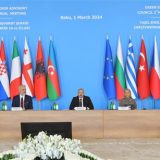The files we follow: NATO/EU relations and neutral and ex-neutral countries; Energy policies and energy dependencies of the EU and Member States; EU/UK/Ireland relations; Environmental policies and issues of the EU and Member States; EU trade policies; Franco-German axis and intra-European relations with frugal countries, Germany/Eastern Europe relations, Nordic countries; Poland/Hungary foreign policies and relations with the EU; Various EU and Member States.
Consider subscribing for free access to the full content!
On 10 June, Turkish President Recep Tayyip Erdogan finally agreed to Sweden’s membership of NATO. Prime Minister Ulf Kristersson hailed “a good day for Sweden” and “a big step towards Sweden’s formal ratification of NATO” (Le Monde).
All that remains is for the Turkish Parliament to ratify the accession, which should pose no difficulties once the Head of State has given his approval. The Secretary General of the Atlantic Alliance, Jens Stolenberg, a long-standing supporter of the process, called it a “historic day“.
In exchange for the Turkish agreement, Sweden notably agreed to support Turkey’s EU accession process, which has been put on hold since the 2016 coup attempt against Erdogan and the hardening of the regime (France 24). However, Pierre Bezanet, France 24 correspondent in Brussels, points out that “reinvigorating doesn’t mean much” for a hypothetical Turkish membership, which hardly enjoys consensus in the Union. However, the agreement does include Swedish support for modernizing the EU-Turkey customs agreement, and for visa liberalization (Le Point).
Sweden’s membership of NATO therefore seems certain, in the face of the final hurdle represented by the Hungarian veto. Hungarian Foreign Minister Peter Szijjarto declared that Hungary’s position was “a support to Stockholm’s membership of the Atlantic Alliance“. The head of Budapest’s diplomacy reduced the question of ratification to “a technical issue” (Le Figaro).
On 11 and 12 June, the 33rd NATO Summit took place in Vilnius, the capital of Lithuania (20 Minutes). This was the fourth summit since the start of the Russian invasion of Ukraine, the 30th and 31st being extraordinary summits in reaction to the invasion. Just before the summit began, Ukrainian President Volodomyr Zelensky called the absence of a formal invitation to his country to join the Alliance “absurd“. Jens Stolenberg replied that Ukrainian membership would be possible once all members had agreed, and when the conditions were right (Europe 1).
Ukraine is one of the non-NATO countries invited to the summit, along with old NATO allies Australia, New Zealand, South Korea and Japan, as well as Georgia, which has been facing Russian occupation of part of its territory since 2008 (Le Quotidien), and Sweden, not yet a member of the Alliance.
At the summit, French President Emmanuel Macron pledged for the first time to supply Ukraine with SCALP long-range missiles (20 Minutes). These weapons are of crucial importance to Ukraine, which can thus hope to strike deep into the Russian occupation army. On 12 June, this initiative was amplified by the G7 countries, which coordinated to ensure lasting material support for Ukraine (Challenges). On the Russian side, Kremlin spokesman Dmitry Peskov declared that the security guarantees granted by NATO to Kyiv were “very dangerous“.
On July 11, NATO members pledged to devote at least 2% of their GDP to military spending (France Info), formalizing the objectives of increasing the strength and operational capability of allied forces.






